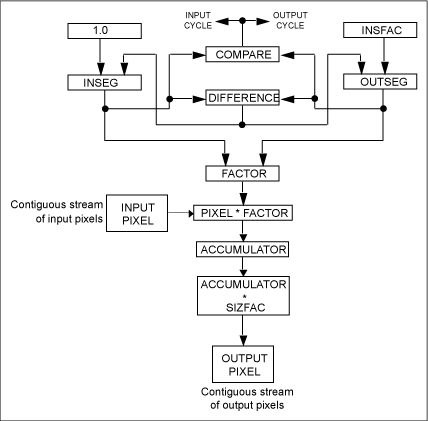Abstract
A
two-pass spatial transform technique that does
not exhibit the aliasing artifacts associated
with techniques for spatial transform of discrete
sampled images is possible through the use of
a complete and continuous resampling interpolation
algorithm. The algorithm is complete in the
sense that all the pixels of the input image
under the map of the output image fully contribute
to the output image. It is continuous in the
sense that no gaps or overlaps exist in the
sampling of the input pixels and that the sampling
can be performed with arbitrary precision. The
technique is real time in the sense that it
can be guaranteed to operate for any arbitrary
transform within a given time limit. Because
of the complete and continuous nature of the
resampling algorithm, the resulting image is
free of the classic sampling artifacts such
as graininess, degradation, and edge aliasing.
The
advantage of a two-pass spatial transform technique
over a one-pass technique has been that it offers
a more effective and efficient match with current
implementation technology. But only part of this
advantage has been recognized. Previous thinking
has focused on the mathematical notion of point,
or coordinate, transforms mapping points of the
output image to points in the input image. Resampling
and interpolating input intensities about the
mapped point to generate the output pixel intensity
is a secondary concern. Distinct advantages can
be gained simply by reversing this order of significance,
that is, by considering first the intensity interpolation
technique and second the way to impose spatial
significance on the interpolation technique.
The
overlooked advantage of the two-pass technique
is that complete, continuous, and time-constrained
intensity interpolation can be conveniently achieved
in one dimension. I will present the basic one-dimensional
interpolation algorithm and then show how two-dimensional
spatial significance can be imposed on the interpolation
algorithm to achieve a two-dimensional transform
mapping.
The
technique was developed intuitively and experimentally
and will be presented in an intuitive style. The
formal mathematical characterization has proved
difficult. However, hardware has been built that
performs two-dimensional image transforms in real
time.
One-Dimensional
Resampling Interpolation
The
one-dimensional resampling interpolation algorithm
maps a limited line of discrete input pixel intensity
values into a limited line of discrete output
pixel intensity values. The mapping is determined
by a sizing factor of the output line in relation
to the input line and by a position factor in
relation to the output line. It can be characterized
by the following formulation, where S is a scaling
factor, a size factor of the output data in relation
to the input data, and I/S is the inverse of the
size factor. Note that S can vary pixel by pixel.
Each consecutive output
pixel = S (1/S consecutive input pixels).
The
inverse size factor indicates how much of an input
pixel contributes to each successive output pixel,
or OUTVAL. The size factor can be a constant for
an entire line of pixels, or it can change for
each new output pixel. The interpolation algorithm
is illustrated in Figure 1.
Figure
1. Resampling interpolation algorithm.

INSFAC is 1/S, or the
inverse size factor; it indicates how much of
an input pixel contributes to each output pixel.
SIZFAC the size factor,
Is a direct multiplicative scale factor from
input to output.
INSEG indicates how much
of the current input pixel is available to contribute
to the next output pixel.
OUTSEG indicates how much
of an input pixel is required to complete the
next output pixel.
Pixel is the intensity
value of the current input pixel.
INSEG and OUTSEG can be
viewed as fractional-valued pointers, or position
markers, in the stream of contiguous input pixels.
|